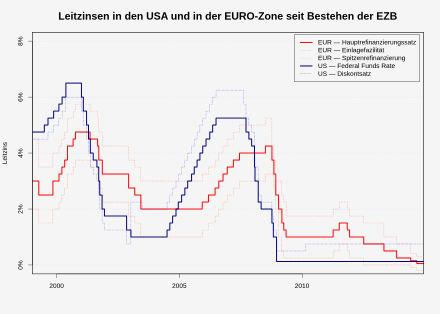Main refinancing instrument
| interest rate | height |
|---|---|
| European Central Bank (valid from: September 18, 2019) | |
| Deposit rate (deposit facility) | −0.50% |
| Base rate (main refinancing operations) | 0.00% |
| Marginal lending rate (marginal lending facility) | 0.25% |
| Swiss National Bank (valid from: June 13, 2019) | |
| SNB policy rate | −0.75% |
| Federal Reserve System (effective March 16, 2020) | |
| Federal funds rate target range | 0.0 to 0.25% |
| Primary Credit Rate | 0.25% |
| Bank of Japan (effective December 19, 2008) | |
| Discount rate (basic discount / loan rate) | 0.30% |
| Bank of England (effective March 19, 2020) | |
| Official Bank Rate | 0.1% |
| Chinese People's Bank (valid from: February 20, 2020) | |
| Discount rate (one-year lending rate) | 4.05% |


: 1 week (green), 3 months (blue), 1 year (red)
The main funding instrument (main refinancing surgery, MRO) is the most important monetary policy instrument of the European Central Bank (ECB). With the help of this instrument, it can indirectly influence interest rates on the money and capital markets and thus control the refinancing costs of commercial banks .
As part of the main refinancing operations, commercial banks exchange central bank- eligible collateral ( securities ) into central bank money for a limited period of time . In a normal market environment, the ECB provides the commercial banks with around three quarters of the monetary base via the main refinancing instrument. The ECB therefore also refers to transactions that are carried out using the main refinancing instrument as main tenders. The interest rate on which these securities repurchase agreements are based is known as the main refinancing rate and is the most important key interest rate of the ECB.
execution
The main refinancing business is one of the open market operations . According to the standard tender, the initiative for open market transactions comes from the ECB. The money is offered to the commercial banks once a week (the dates are announced at least three months in advance by means of the non-binding tender calendar ) for a period of one week (before 2004: 2 weeks). The national central banks handle the business for the ECB.
After assuming its monetary policy responsibility, the ECB carried out main refinancing operations using the fixed-rate tender procedure from January 1, 1999 . On June 26, 2000, the ECB switched to the so-called interest rate tender procedure : The central bank specifies the amount of money to be issued and also sets a minimum bid rate, i.e. the minimum interest rate at which it conducts open market transactions. For the main refinancing facility, this is the main refinancing rate . The commercial banks interested in refinancing will now name the interest rate at which they are willing to carry out the transaction as part of the tender process. The allocation of funds takes place after the end of the bids according to the amount of the interest offered. The ECB uses the American procedure for this .
During the financial crisis , the ECB reverted to the set tender procedure in October 2008.
meaning
The central bank money supply is usually small compared to the money supply M3 in public circulation and has no fixed relationship to it. Apart from the cash in customer possession, it is also not part of the money supply M3, since central bank balances only serve as means of payment between banks. Nevertheless, changes in key interest rates have a significant impact on the economy as a whole. So they put z. B. upper and lower limits for the money market interest rates (see EURIBOR or LIBOR ), at which commercial banks grant each other loans, since an interbank loan could be substituted by the transfer of central bank money . Via the medium to long-term outlooks of the central banks and other transmission mechanisms, changes in key interest rates also affect savings and loan rates for longer periods and other variables in the economy such as wage levels, inflation or economic growth. The European Central Bank orients its monetary policy primarily to its inflation target, other central banks also to growth or employment targets.
Due to the competition among the commercial banks , the interest on the money market is passed on to the interest on loans and deposits, as explained under Money Creation (Section Consideration of Interest ).
The very short term is the great advantage of the main refinancing instrument, as it means that the conditions for a large part of the refinancing volume can be redefined every week. This means that the ECB can influence the money market at all times through the main refinancing instrument . In an economically bad phase, it pursues an expansionary monetary policy (which makes loans cheaper), in an economically good phase a restrictive or contractionary monetary policy (which is intended to keep inflation low). The latter monetary policy can also be pursued in a worsening economic phase if the rate of inflation should become too high. This step is usually carefully considered by the central banks.
classification
The longer-term lending of money at the ECB takes place via the longer-term refinancing transactions . Short-term lending is done through the marginal lending facility .
Web links
Individual evidence
- ↑ Deutsche Bundesbank, Monthly Report April 2017 , The role of banks, non-banks and central banks in the money creation process, page 16
- ^ The monetary policy of the ECB 2011 , page 64
- ^ The monetary policy of the ECB 2011 , page 9